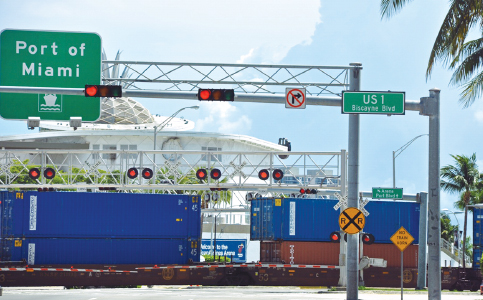As imports rise, PortMiami expects 3% cargo increase
Advertisement

PortMiami cargo has been growing after Covid-19 slowdowns and is expecting a conservative increase rate of 3% year-over-year as demand for all types of imported commodities continue to increase and new trends leverage closer manufacturing regions and avoid international conflict.
Last year, PortMiami recorded a cargo performance high of 1,254,062 TEUs (20-foot equivalent units, a standard measure of cargo), accounting for an increase of 17.56%, or 187,324 TEUs, over fiscal 2020, said the director of public affairs and communications from PortMiami, Andria C. Munoz-Amador. “Based on historical data, moving forward, we expect cargo at PortMiami to continue increasing at a conservative rate of 3% year over year.”
In the 2021 fiscal year, which ends in September, trade volume has grown 18% from last fiscal year. Trade with all regions has grown as well, ranging from 7% more volume with Europe, 15% more with Asia and 25% more with Latin America, she said.
Demand for every type of commodities keeps increasing, and new trends and disruptions in the global supply chain are giving East Coast seaports, including PortMiami – which has an economic impact of $43 billion and creates about 334,500 jobs – leverage to receive more cargo shifting from the West Coast to the East Coast.
“Nearshoring is a new trend, [in which ports are] taking a lot of manufacturing that’s going on in Asia, China, Vietnam, and bringing it closer to the Western Hemisphere, to Mexico, Latin America,” said Hydi Webb, director and CEO of PortMiami at the 2022 SMART Trends Transportation Summit on June 3. “That is good, because geographically Miami is situated perfectly to go after all these new cargos.”
The Miami-Dade County Commissioners last November passed legislation to support friend-shoring – another term for nearshoring – which would bringing manufacturing closer to the West. “We’re looking at seeing a lot of more of the North-South trade increasing through the Port of Miami,” said Ms. Webb.
Currently, PortMiami has two Florida East Coast (FEC) Railway trains coming in and out of the port every day. Each train bring 60 to 80 containers into PortMiami from inland US, said the port communications director. Outgoing trains haul 50 to 60 containers daily into Central and North Florida and the Southeast of the nation.
Rail cargo volumes have been increasing in the last years, according to data from PortMiami. During the 2021 fiscal year, FEC trains moved 37,938 containers by rail in and out of PortMiami, 52% more than fiscal 2020 fiscal, when FEC trains moved 24,908 TEUs. Volume was up 44% from the 2019 pre-pandemic level. “That means that PortMiami’s rail volumes have been growing despite the trade disruptions,” said Ms. Muniz-Amador.
About 5% of all PortMiami cargo is shipped in and out of the port by rail, she added, and with new development projects, PortMiami expects its rail cargo to increase 20% in volume at the port.
March and October have seen the most cargo volume, correlating with the months that also have the highest rail volumes, with an average of 3,100 containers per month moving by FEC trains.
Seaboard Marine is the main user of FEC rail at PortMiami, with 75% to 80% of all FEC volumes at the port and focused on Latin America and the Caribbean.
“A lot of this growth [in cargo] is possible due to the county’s investments over the last couple of years, and we’re very proud to say that since the Deep Dredge opened, we have been able to open over 600 post-Panamax vessels that we would have never been able to offer prior to that dredge,” said Ms. Webb of the $220 million deepening of the harbor channel in the Miami River to 52 feet in 2015.
PortMiami is also looking into buying more cranes. “We have about 13 cranes, we’re going to put an RFP next year to purchase [around] four more cranes,” she said.
The general rail use surged 47% last year from 2020, an increase of 45.7%. “We’re finding that people want to send their cargo on the rail through Central Florida, and throughout the state,” Ms. Webb added. “There is a lack of truckers going on right now, so it makes rail a little bit more efficient now.”
Among the diverse shipments being hauled from PortMiami by the FEC railways service is cotton. Cotton, said Ms. Munoz-Amador, is one of the main products shipped by rail to PortMiami to be exported to Central America, where it is to be manufactured into apparel. The apparel is then shipped back to Miami and transported by FEC rail to the Southeast and Northeast.
Garlic is also imported from the port to Central and Northern Florida and other areas though the trains.
Additionally, shipments of furniture imported from Latin America increased 135% last year; vehicle parts shipments increased 65%; beverages imported from Europe increased 17%; and medical supplies also surged over the last year, said Ms. Webb at the transportation summit. “The volume that comes through here is very viable and we don’t see that stopping for quite some time.”
“The poultry industry also uses FEC trains to rail down its products to PortMiami, then export them to the Caribbean and Central America,” said Ms. Munoz-Amador. “The Caribbean especially is highly dependent on US poultry supply to sustain its consumption and its tourism industry.”
PortMiami also anticipates cargo to continue to grow in the next five years from 1.25 million TEUs to 1.8 million. “We’re very proud to say that throughout the pandemic, we had an open channel with no congestion,” Ms. Webb said. “We’ve had, over the last six years, over a million TEUs that come to the port in an annual basis.”
On the Container Port performance index of 2021 by the World Bank Group and S&P Global Market Intelligence, PortMiami ranked as best port in Florida and second best in North America for efficiency.
“What’s next?” said Ms. Webb. “Net zero. Net-shoring is a phenomenal, visionary and transformational program, where we see that we can develop the nation’s first end-to-end net zero carbon reduction [port], in line with the county and the mayor’s goal of a 2030 reduction of emissions by 50%.”


